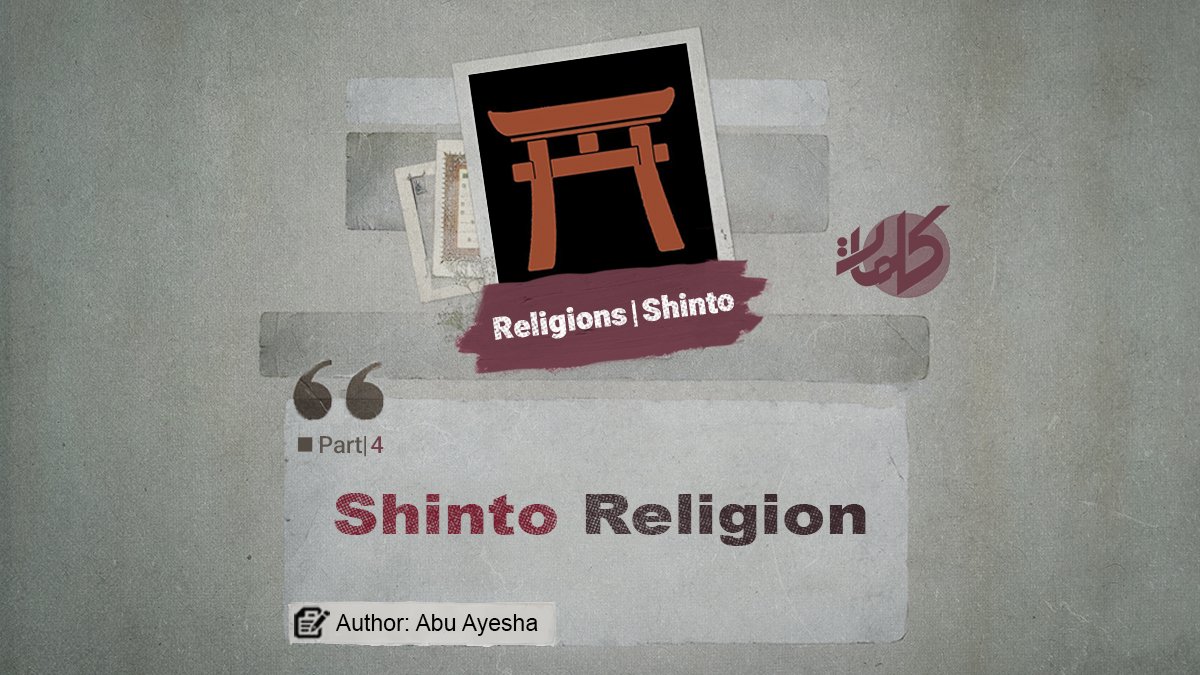Author: Abu Ayesha
Shinto Religion (part 4)
Forms of Shinto
In the Shinto religion, there are three forms: the worship of family ancestors, the worship of clan ancestors, and the worship of Japanese emperors and deities. The emperor or his representatives would commemorate the heavenly ancestor of the imperial lineage seven times a year, and on occasions when the country engaged in sacred acts, prayers were recited in his name. Shinto did not consist of complex beliefs, ceremonies, moral codes, or special priests, nor did it speak of paradise or immortality. It only required believers [those who adhered to this faith] to occasionally visit sacred places and, with piety and devotion, pay respect to the past and to the emperor’s ancestors.[1]
Some, however, believe that Shinto exists in four forms.
“Throughout history, Shinto religion has had followers in various social layers, adapting to the characteristics of each layer. Therefore, one can generally speak of four kinds of Shinto, which are:
-
Shrine Shinto;
-
Imperial Court Shinto;
-
Sect Shinto;
-
Popular Shinto.
All four of the above share agreement in their epistemological aspects, particularly in adherence to ancient history and Shinto mythology; however, in terms of religious rituals, they differ, and each has its own manifestations and symbols.”[2]
It should be noted that this opinion is not unanimously agreed upon, because the author of Encyclopedia of the History of Religions, Firas Al-Sawwah, identifies more than these forms of Shinto. In his book, he mentions five types of Shinto and elaborates on each. Below, we briefly summarize them:
-
Imperial Court Shinto
This form of Shinto refers to ceremonies held for the spirits of emperors and ancestors, performed in an official and governmental institution. The distinction of this form lies in the emperor himself attending and performing the rituals. Furthermore, it encompasses some of the ancient acts of worship that have remained relatively unchanged over time. Despite its significance, participation in these ceremonies is not open to the general public.
-
Priestly Shinto
This form of Shinto is characterized by a comprehensive system of beliefs and its emphasis on traditions and religious movements held in honor of the Kami. In December 1954, State Shinto was abolished, and with the establishment of the “Association of Shinto Priests” in February 1946, Priestly Shinto was separated from State Shinto and acquired its own distinct religious identity.
-
State Shinto
This was a political initiative that began during the Meiji era in 1868. State Shinto represented a blend of Priestly Shinto and Imperial Shinto. It took years for this form to develop into a unique institution distinct from other religions. As a governmental system, its priests and worshippers were treated similarly to government officials.
-
Sect Shinto
Sect Shinto refers to thirteen religious organizations that emerged in the later Edo period and early Meiji period. Until the end of the Edo era in 1868, the government favored Buddhism while neglecting Shinto and prohibiting Christianity. When the Meiji government came to power, it elevated the status of Shinto while disregarding Buddhism. However, later under pressure from Western governments, Christianity was also allowed to appear.
-
Folk (Popular) Shinto
This form of Shinto was a mixture of superstitious beliefs and magical-religious practices for the general population. Unlike Buddhism and Christianity, Popular Shinto had no laws, no doctrines, and no formal membership. It arose from incorporating Shinto customs and views into daily life.[3]
The Myth of Shinto in History
The mythology of Shinto is highly intertwined and lengthy, requiring careful attention to the events surrounding its origins, which gave rise to significant occurrences. This ancient myth stemmed from the feelings and emotions of the people toward the manifestations of nature and did not advance much beyond primitive animistic beliefs. For example, the male deity Izanagi and the female deity Izanami represent the Japanese people’s conception of the universe: the former being the god of heaven and the father of all, and the latter being the goddess of earth and the mother of all. The details of the events between them symbolically refer to natural phenomena, such as the passing of seasons and the cycles of vegetation and water.[4]
Continues…
Previous Part / Next Part
References:
[1] Kojiki: The Sacred Book of Shinto, translated by Dr. Ehsan Moghaddas, First Edition, Winter 1380 A.H. Solar, pp. 16–17.
[2] Website of Dr. Mehdi Rahbari, article title: Shinto Religion, Japan’s Official Religion, published in 1392 A.H. Solar.
[3] Al-Sawwah, Firas, Encyclopedia of the History of Religions, Volume IV, translators: Saif al-Din Al-Qusayr, Mahmoud Munqidh Al-Hashemi, Abdul-Razzaq Al-Ali, Wafaa Tuquz, 2017, pp. 411–413 (abridged and excerpted).
[4] John Noss, Man’s Religions, translated by Ali Asghar Hekmat, 3rd Edition, 1354 A.H. Solar, in collaboration with Franklin Publishing Institute, p. 280.



